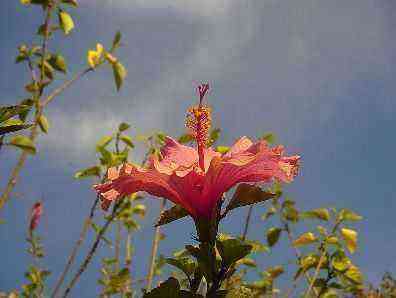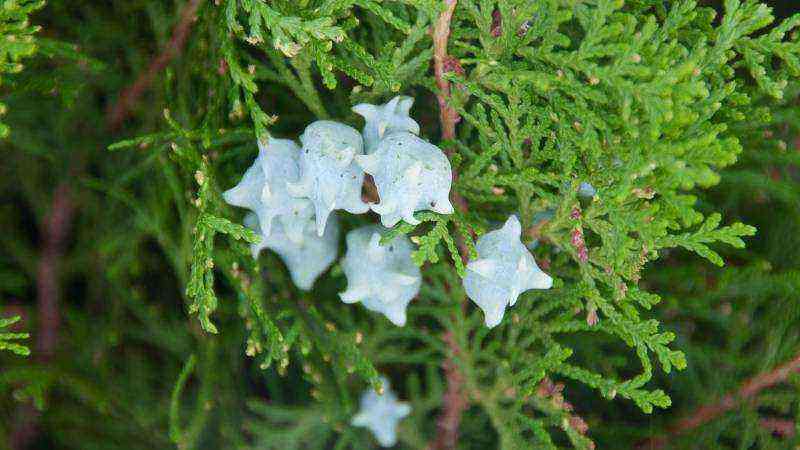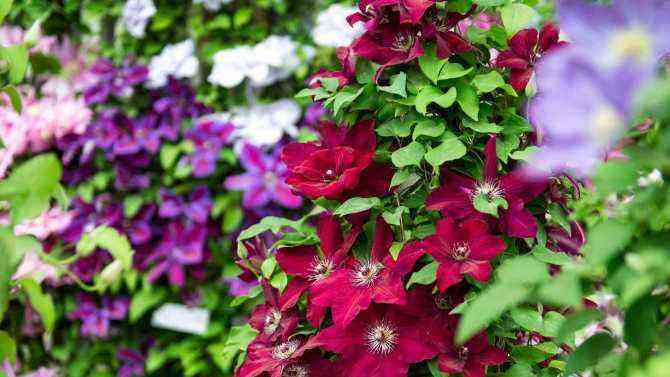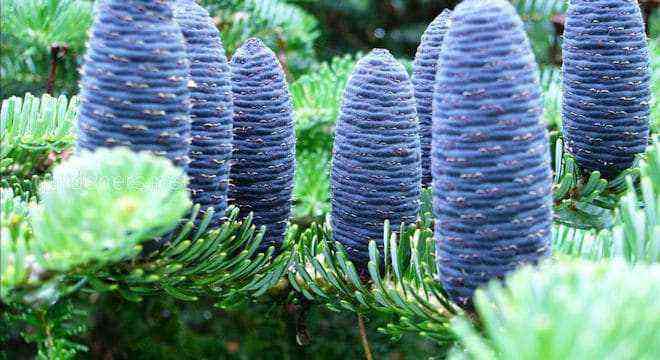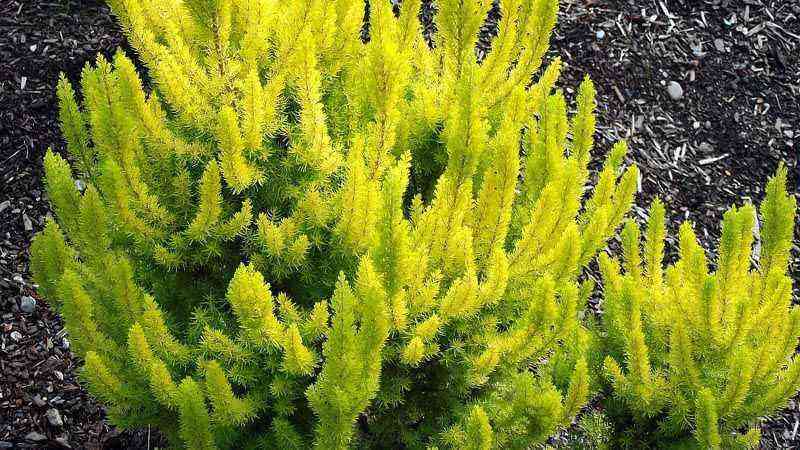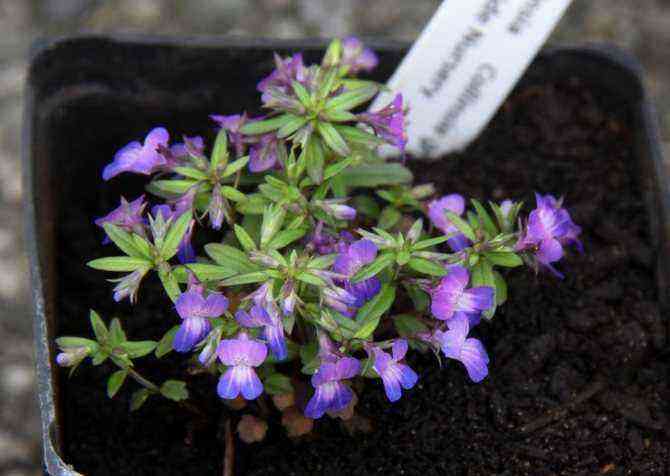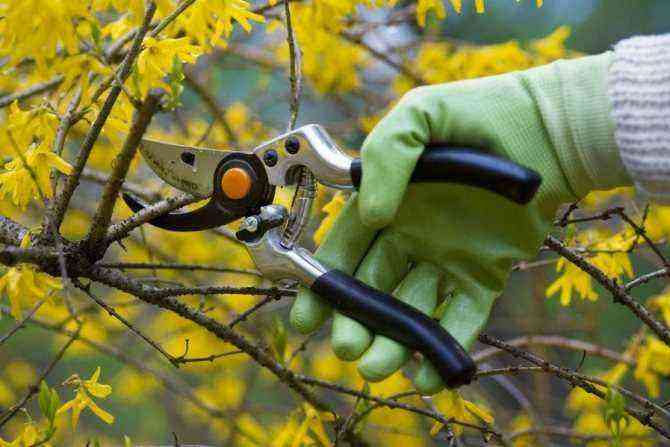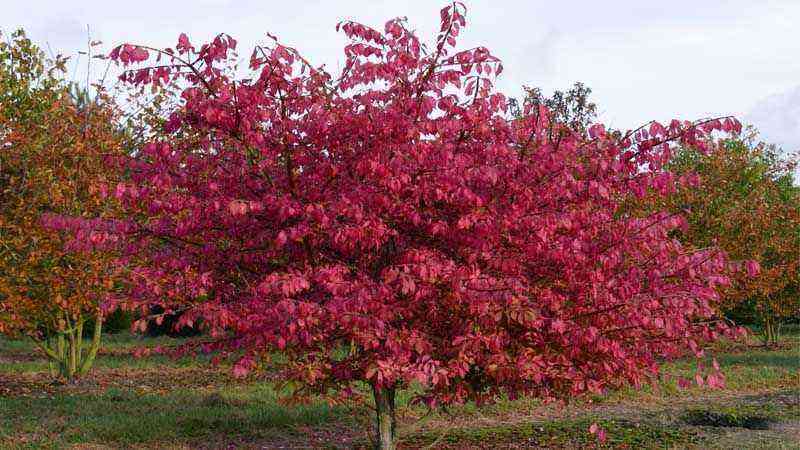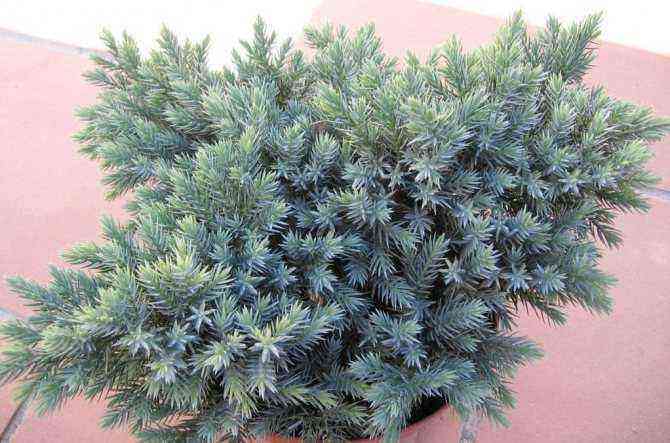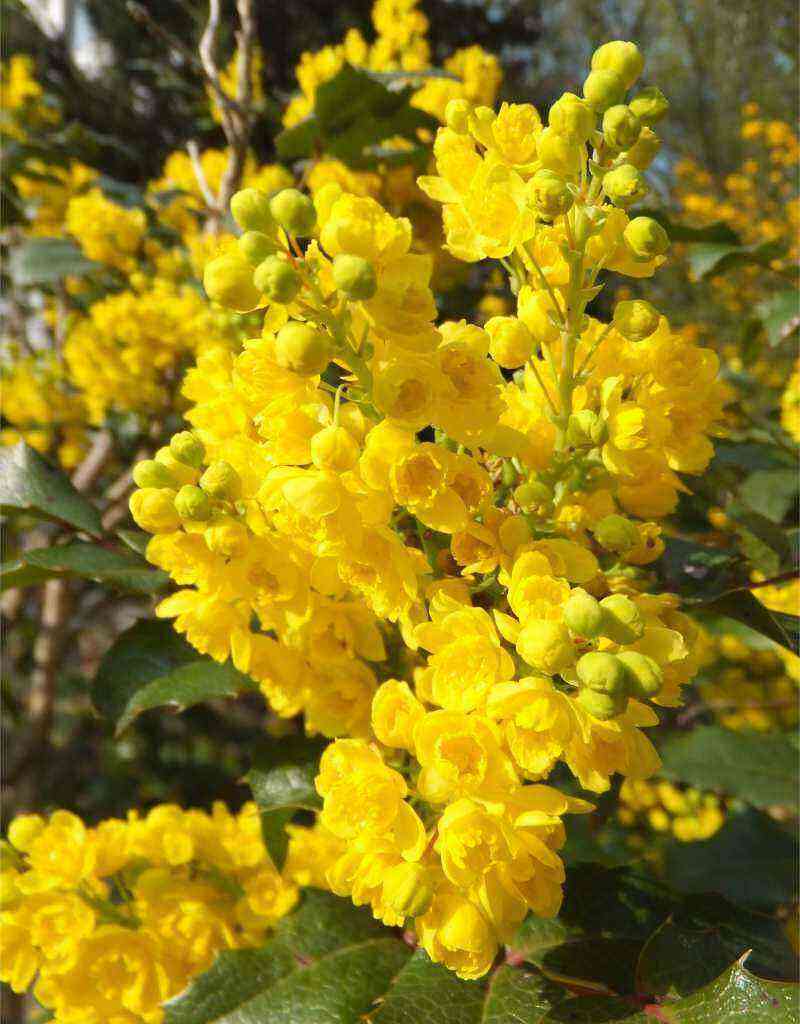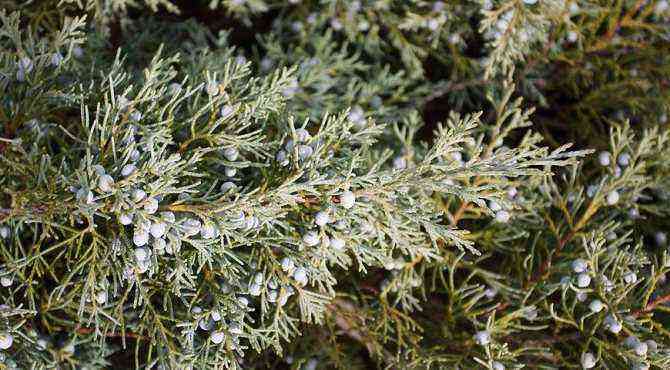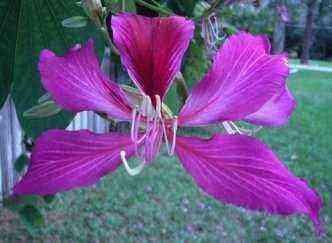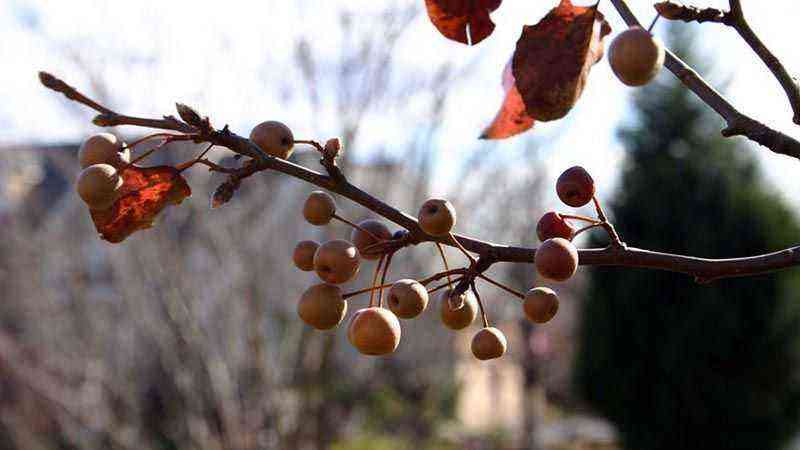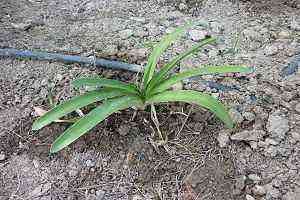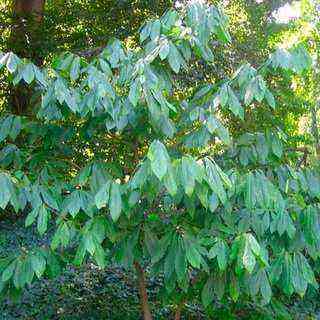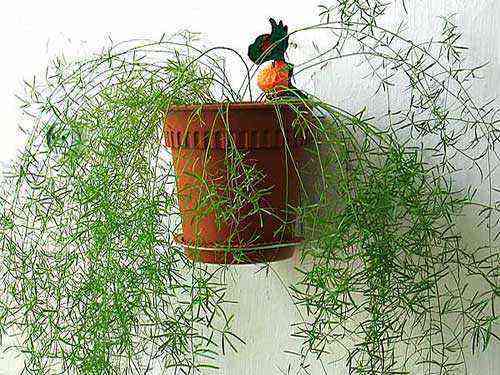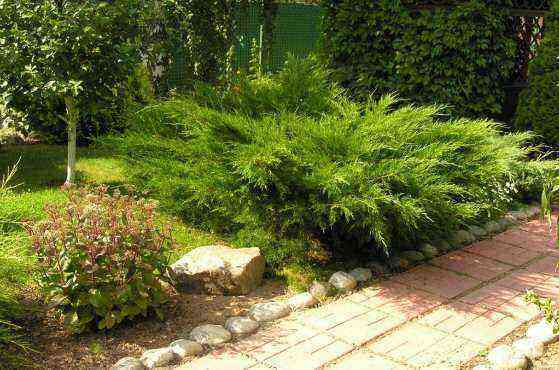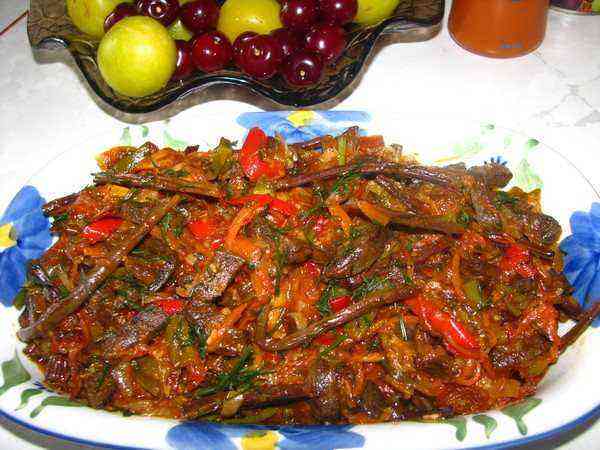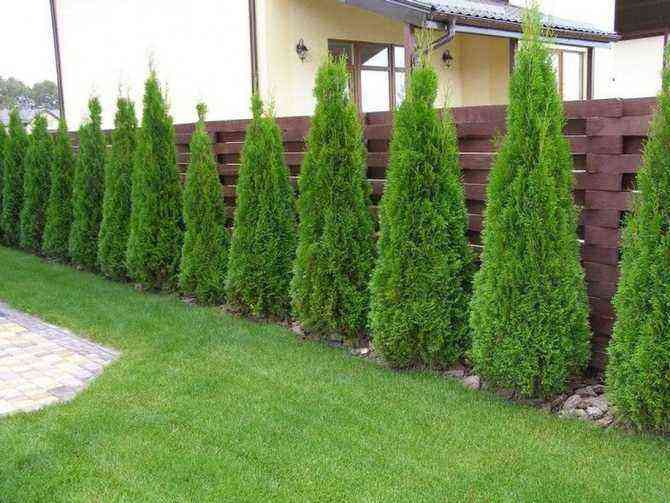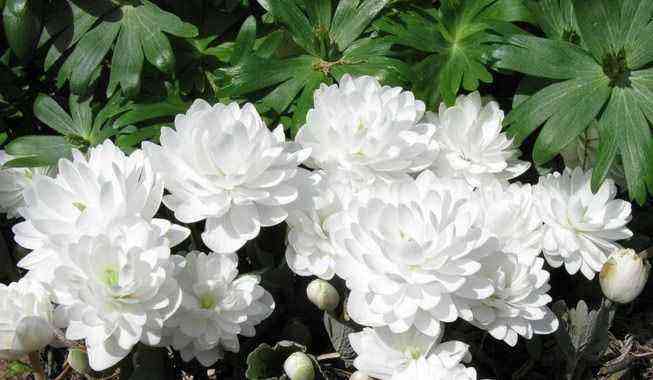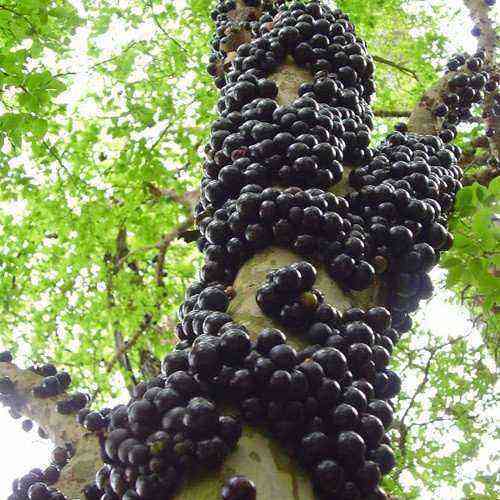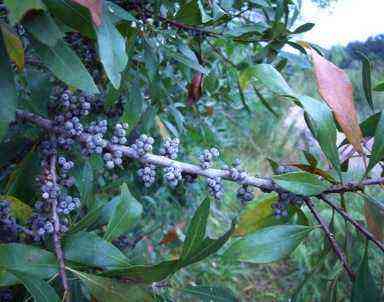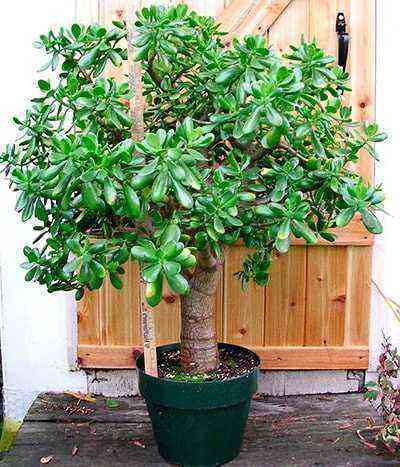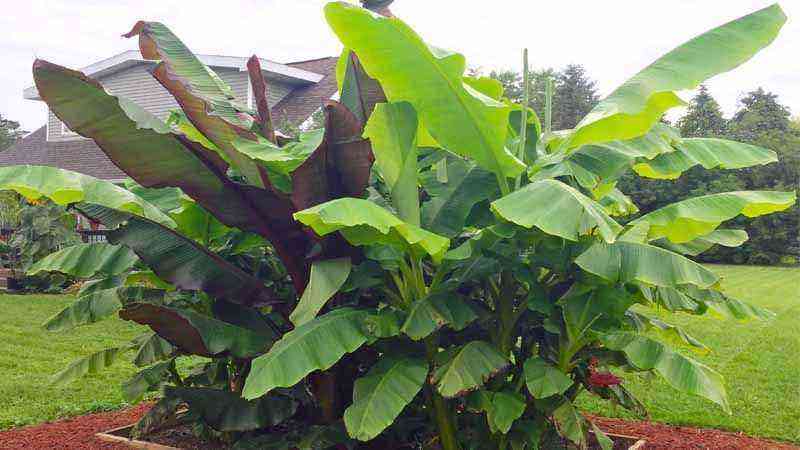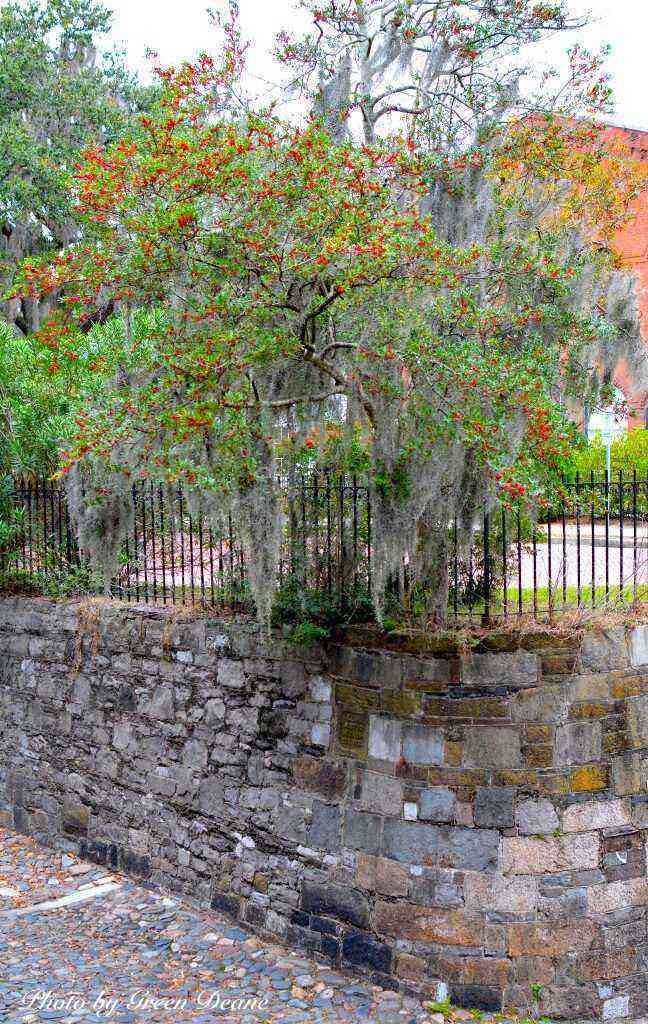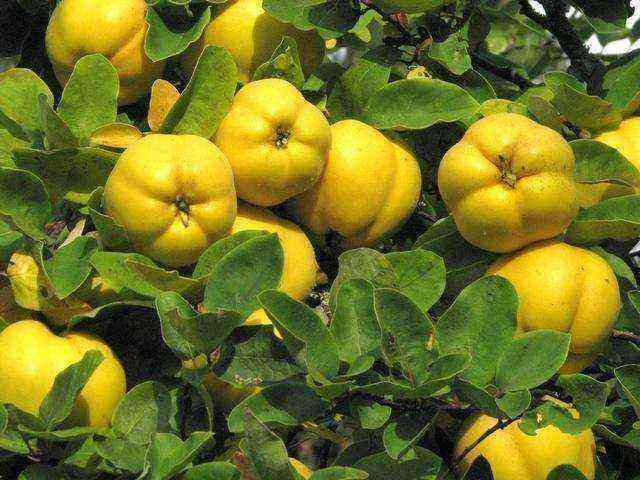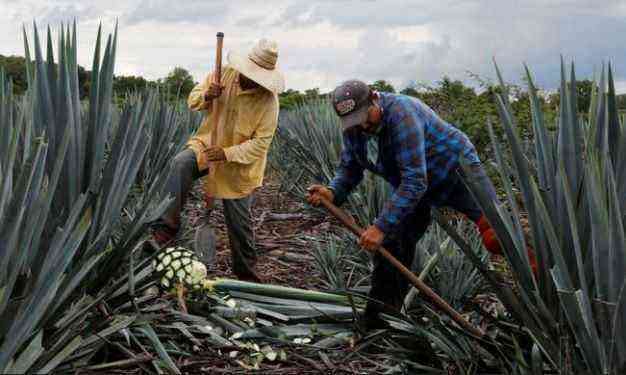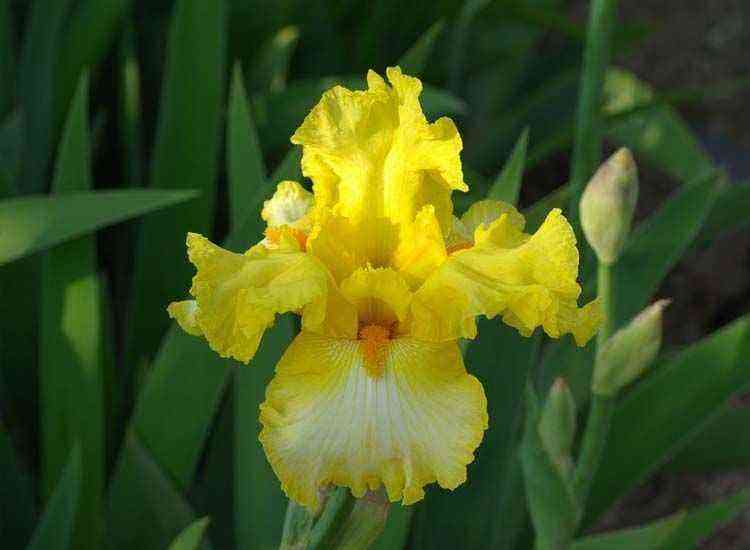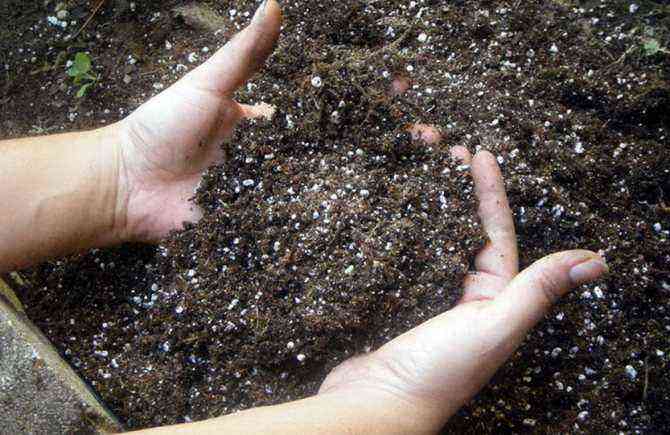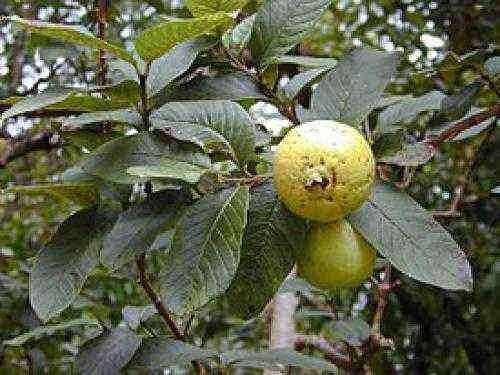When to plant junipers in autumn
Not everyone knows that autumn is a good time of the year for planting junipers. If a seedling has a powerful rhizome, then when planted before November, it has every chance to take root and safely adapt to the low temperatures of winter. Caring for junipers in the fall and preparing for winter is an event that requires a serious approach.
Important! The end of winter is not a reason to relax. A coniferous tree can also die in the spring, when the rooting process is completed: at this time, recurrent frosts occur. The cause of the trouble may be a weak, diseased root or a violation of an earthen coma. It is worth noting that small specimens are recommended to be started in the spring. Thus, before the winter frosts, they will be able to take root and withstand bad weather.
Juniper planting time
You can plant junipers in open ground in spring or autumn. Spring planting is carried out after the snow melts, in March-April. If you plant the seedlings later, there is a good chance that the needles will burn in the bright spring sun.
If the root system of the purchased seedling is closed, it can be planted throughout the summer season, taking care of shading the crown in the daytime.
With an autumn planting of juniper, there is a high probability that the seedlings will not have time to take root and will die in winter. Therefore, this method has its own characteristics and rules, the observance of which increases the chances of success.
Features of the autumn landing
It is recommended to plant juniper seedlings in autumn in the second half of October. With such a time frame, the plant will have time to adapt to new conditions and get stronger. If the plant is planted later, it may die from winter frost.
The basic landing rules are similar to those described above. After planting a seedling, the ground around it is mulched with spruce branches or other material. This will not only prevent rapid evaporation of moisture, but will also protect the roots from winter frosts.
Before the snow falls, the crown of the tree is tied up so that the branches do not break off under the weight of the snow, and then wrapped with a covering material that will protect the tree from the cold. This measure is necessary even for winter-hardy species and varieties, since a young seedling is not yet strong enough for independent wintering.
In the last winter and first spring months, the insulating covering material is replaced with sunscreen, since the delicate needles of the crown can burn under the bright spring sun. In early spring, the process of rooting the seedling will be completed and it will be ready for independent life in a new place.
How to plant junipers in the fall
Before planting a juniper seedling in a new place, in the fall, a year before transplanting, the plant is deeply dug in: the diameter should not be less than the diameter of the crown. Next, the rhizome is trimmed and the juniper seedling is given time to recover.
It is also necessary to know that mature plants are also unsuitable for transferring to a new place. Even under ideal conditions, a mature specimen will not tolerate stress. If, nevertheless, transplanting an adult plant is inevitable, it is worth trying to plant a juniper in winter, when the root ball is sufficiently frozen. When performing such a procedure in February, you can count on the probability of the survival of the seedling.
Landing site preparation
Soil structure does not play a decisive role. In the matter of land, juniper is undemanding, but when choosing a place, light and loose soil should be preferred. An exception may be clay soil – the seedling will not take root on it. Only the Virginia juniper bush can assess the properties of clay.
If you scrupulously adhere to the rules, then the Central Asian and Cossack varieties take root best in alkaline soil. Siberian – loves sandy loam and sandy soil. For the rest, acidic soil is more acceptable.
In the spring or in the middle of autumn, a new place is selected for the plant. Juniper takes root perfectly in sunny areas. In this case, it is important that the light of the sun comes in during the day. If the seedling is placed in the shade, it will not be possible to form a beautiful shape from scanty branches. Moreover, the color of the plant will become pale, uninteresting. The dimensions of the recess for disembarkation are twice the size of an earthen lump, they introduce a drainage layer consisting of broken bricks, pebbles and sand. The thickness of the layer varies from 15 to 25 cm.
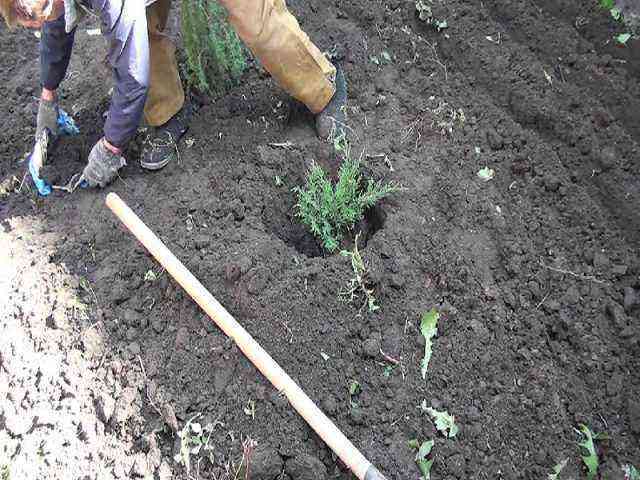

Seedling preparation
Before submerging the seedling in the ground, it should be treated with a growth stimulant. When planting in dry soil, the bush is pre-saturated in a container with water, protected from direct sunlight.
The pit is filled with water, the soil is thoroughly moistened. To prevent the attack of insects, the juniper seedling is watered with special chemicals after planting. This action must be carried out repeatedly until the plant “gets sick” in a new place.
A step-by-step guide on how to plant a juniper in the fall
If you adhere to the recommendations of experienced gardeners and follow a step-by-step algorithm of actions when preparing a juniper for winter, the growing process will not create difficulties. Correct organization of actions:
- In the prepared soil, the landing sites are outlined. The interval between seedlings is maintained at 1 – 5 m.For varieties of dwarf species that do not tend to grow, the distance is reduced to 2 – 0 m.
- Pits are prepared, focusing on the root system. They should be twice the size of an earthen coma. The approximate dimensions of the hole for a three-year-old seedling are 50×50 cm.
- A drainage layer of broken brick and sand (15 – 20 cm) is brought to the bottom of the pit. A mixture of soil, turf, sand, peat is also poured in.
- Before the autumn planting of juniper for the winter, it is recommended to add up to 300 g of a nutrient – nitroammophoska to the hole. The drug is classified as universal, it is suitable for all types of garden plants.
- The pit is allowed to stand for 21 days. Thus, the soil will settle, and when planting a juniper seedling, the rhizome will not additionally suffer.
- A seedling is immersed in the hole, covered with earth, fertilizers are not applied.
Cultivation from seeds
Novice gardeners often wonder how to grow a juniper from seed. In fact, the reproduction of this plant species occurs in two ways:

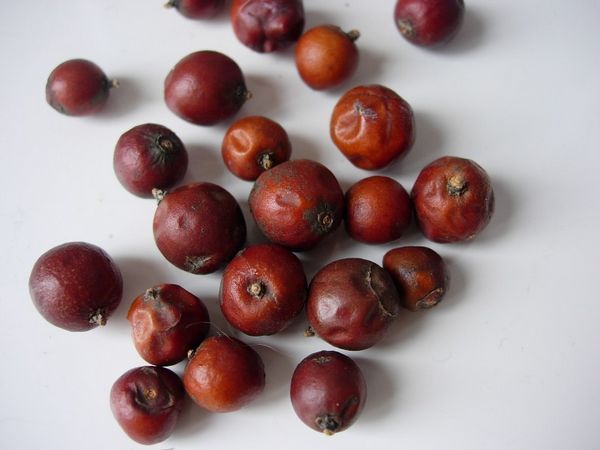
Juniper berries
But it is not possible to collect full-fledged seeds from all species. Juniper seeds are harvested from adult plants that are two years old. The berries darken in the process of ripening, this is what is a sign that the collection can be carried out. Further, the material must undergo stratification, in other words, it is hardened by cold. For this, the seeds are sown in special containers filled with the soil necessary for the variety, and taken out into the cold, so they are stored for up to 5 months. After this process, the material is already planted in open ground in early spring.
The shell of the seeds is rather coarse and dense; in order to accelerate growth and the adaptation process, they must be scarified before sowing, i.e. subject to mechanical stress (damage). The seeds can then be sown outdoors. The planting material is deepened into the ground by about 2-3 cm, no more, while keeping the distance in mind. In the future, it is necessary to carry out regular watering and protect, as necessary, young shoots from the sun’s rays. Seedlings are transplanted to a permanent place only after 3 years. The plant is removed along with a clod of soil on the roots, which will make it easier for it to take root and acclimate to a new place.
Juniper care in autumn
There are no special requirements for the care of junipers in the fall. It is distinguished by good endurance, survives cold winter temperatures and drought in the heat, but on condition that the root system has completely taken root. A transplanted plant needs watering, since a weakened root cannot always go deep into the bowels of the earth to recharge. Irrigation of the seedling will be useful.


How to water a juniper in the fall
Only a year after a successful planting, the juniper can not be watered in autumn and even summer. If the heat is aggressive and drying out the soil, the plant is watered abundantly, but not more often than once every 14 days.
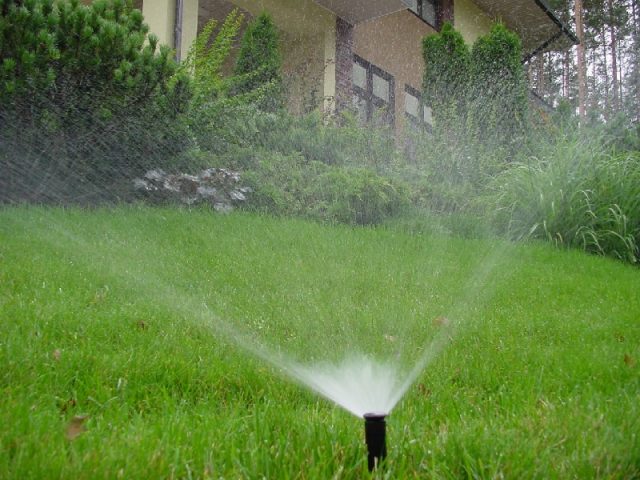

How to properly prune junipers in the fall
Pruning of common juniper in the fall is carried out if the plant is grown for the purpose of decorating the site. Figuratively form or simply remove excess processes. It is also necessary to eliminate dry, broken, limp branches. The rules for cutting seedlings are universal for all conifers. The plant must be well-established, with no signs of disease. For some varieties, it is impossible to form a crown.


Juniper pruning in the fall is not always carried out according to the scheme. The choice of shape should be appropriate for the landscape. Sometimes gardeners leave a natural crown.
How to feed
When planting a juniper in the fall before winter, the plant should be saturated with fertilizers. Thus, before the cold weather, the support of the easily injured root system of the seedling is carried out.
For fertilization, humus that has stood in a pile for at least 1 years is used.
If humus was introduced into the soil during planting, the manipulation is not repeated for the next three years. The fact that there is an excess of nitrogen in the earth will be indicated by the yellow color of the needles, dry branches.
To make compost, the top layer of soil above the roots is dug up, watered and mulched.
Care instructions
Unpretentious and capricious juniper does not require much attention. However, following some rules, you will save the beautiful appearance of the plant and ensure long life.
Watering and feeding
Plant able to withstand without watering for a long period. However, in hot dry summers it is recommended to water it at least once a month.
Also periodically arrange a shower using a spray bottle or other sprayers. The procedure is carried out every week in the early morning or evening, when the sun is not as active as during the day.
In the spring, they introduce into the soil under the plant nitroammophos at the rate of 45 g per square meter. During the summer, you can fertilize the juniper with organic or mineral fertilizers no more than once a month. Such feeding is carried out if the tree is growing slower than it should be.
Transfer
It is carried out only if absolutely necessary, because there is no guarantee that the juniper will take root in a new place.
Juniper transplant strongly dislikes!
If you still decide – prepare optimal soil… It is best to mix coniferous soil, peat, sand in equal parts. Water the tree abundantly after placement.
Pruning and grooming in winter
The plant itself is perfect does not require pruning… All that is needed is to remove dry branches at any time. However, when forming a beautiful crown, you can cut off excess branches using a sharpened tool.
You can’t cut many branches at once – tree may get sick.
Young plants harbor in the first couple of years lutrasilom or other similar material. Older plants with a spreading crown are tied with rope or twine to prevent branches from breaking due to snow. You can also periodically shake off the attacking snow from the tree.
Juniper care in spring
When the sun becomes active and the snow slowly melts, a very dangerous period begins for all types of junipers. They are may dieunless you take action.
The sun is capable of literally burn the needlespreviously under the snow or simply unaccustomed to the burning rays. To prevent this, it is necessary to shade the plants with burlap, thin cloth or other covering material.
After the snow melts, remove the covering material, clean the trunk circle of fallen leaves and other organic debris. The layer of mulch is removed, as it can lead to rotting of the roots. The soil is dug up or loosened. When the soil dries up, the threat of rotting will go away, a fresh layer of mulch is poured.
How to care for junipers in winter
Juniper is resistant to low temperatures, so in winter there is not much work on caring for the tree – all the main preparatory activities are carried out in the fall, before the arrival of winter. To prevent snow drifts from breaking the crown, the bushes are tied up. It is especially characteristic of juniper plants that have undergone formation to “crumble”.
Is it possible to prune junipers in winter
The best time to form a bush is considered to be spring and summer. If we are talking about the middle lane, then the second half of summer for haircuts is already undesirable. Juniper may not have time to “get sick” before the onset of the cold winter.
Juniper pruning in the fall is carried out for sanitary purposes, to remove dry and damaged branches, without touching the living. Before starting the procedure, you should make sure that the plant is healthy. If in doubt, the formation of the bush should be postponed until spring.
In winter, you can also use sharp garden shears, but only cut dry branches, without affecting the living fragments.
How to water a juniper in winter
In winter, the juniper is watered only if it grows at home, on the windowsill. Watering frequency does not exceed twice a month. The coniferous culture loves to be irrigated every other day. In this way, dense, lush greens are obtained.
Do I need to cover the juniper for the winter
The bush can withstand low temperatures, but if the juniper has not reached three years, it must be sheltered for the winter in the fall. Some varieties tend to react negatively to temperature changes in spring. The fact that the juniper is not comfortable when changing from minus to plus and vice versa will be indicated by the faded shade of the plant and the yellowish-brown color of the branches.
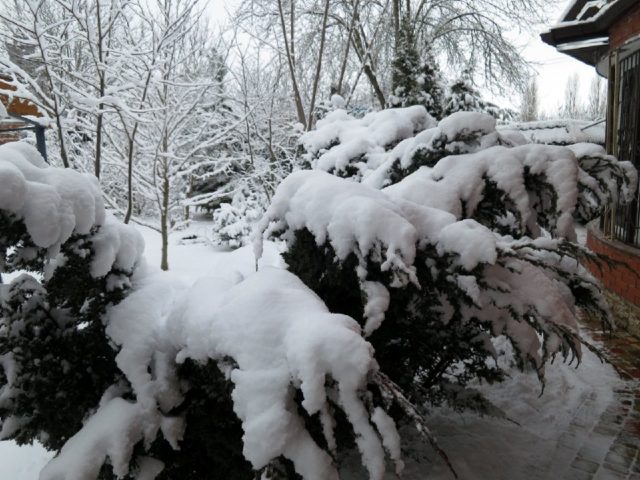
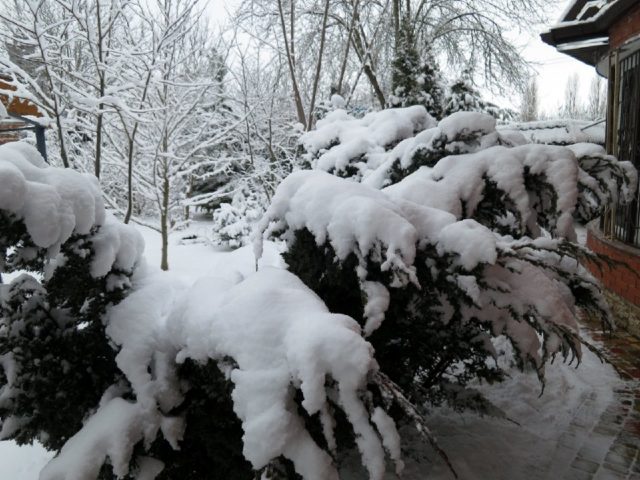
How to cover a juniper for the winter
Juniper shelter for the winter is carried out at the end of autumn using any of the proposed methods:
- In regions with snowy winters, the easiest way to cover the root system is to use snow. After the first snowfall, the previously tied bush is insulated with a snowdrift. For these purposes, only freshly fallen precipitation is suitable. The procedure requires care, as it is important not to damage the branches and trunk.
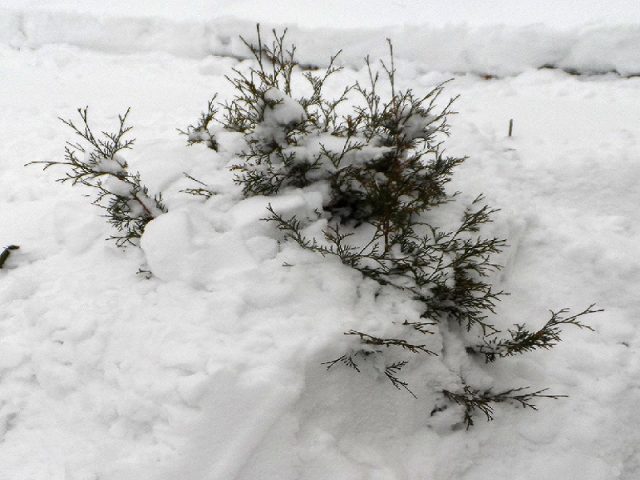

- Young non-voluminous shrubs are superbly insulated with pine spruce branches. Large ones are tied with needles, small ones are covered on top.
- In regions where snow falls unstably, agrofibre or burlap is most often used to shelter juniper plants. The crown is wrapped in such a way that the bottom of the tree is open. How to properly organize the process of saving a juniper in winter is well shown in the photo sites and forums of gardeners on the Internet.
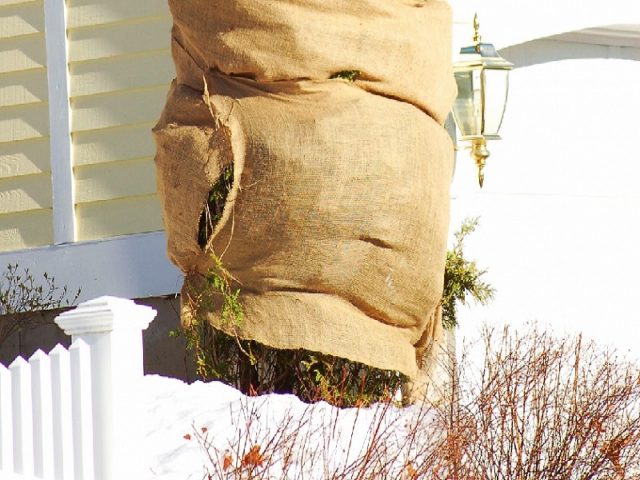
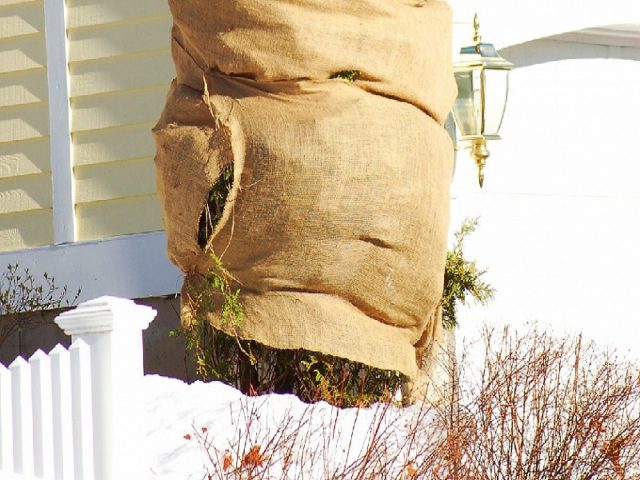
- An interesting and effective way to insulate a juniper is to install a reflective screen. Having placed it on the side of the sunlight, they ensure that the rays grill the crown.
If the seedling is not permanently planted, it can be brought into greenhouse conditions for the winter in late autumn. Thus, additional care is easily avoided. Particular attention should be paid to preparing junipers for winter in regions where temperatures drop to -30 o C.
Popular species and varieties
About 70 species of plants are included in the genus of juniper, they differ from each other in structure, color and height. With their help, gardeners carry out the design of rockeries, alpine slides and hedges. Popular types and varieties include:
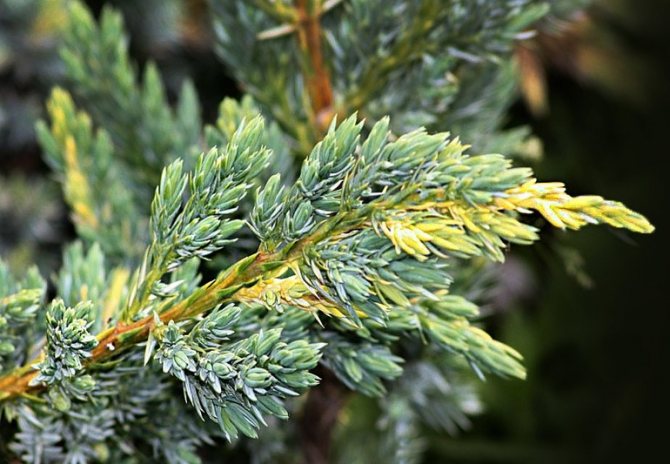
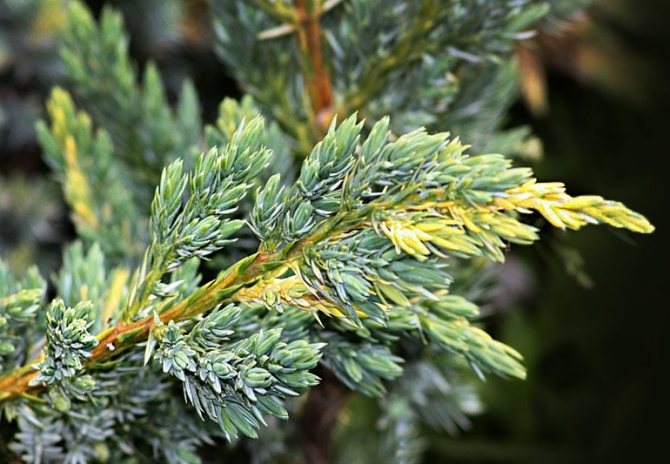
- Ordinary. The most common species that grows on the territory of Russia from the Caucasus to the Polar region. It is resistant to frost in winter and drought in summer. It grows on almost all types of soil and can reach 5 to 10 m in height. In the third year of development, the first cones appear in the plant. Common juniper varieties: Green Carpet, Hibernica, Repanda, Suesica, etc.
- Rocky. Occurs in the form of dioecious trees and shrubs. In nature, it grows up to 10-18 m in height, the trunk diameter ranges from 0,8 to 2 m. The specimens growing in the garden are much smaller. The most famous varieties of rocky juniper: Skyrocket, Blue Angel, Blue Arrow, etc.
- Horizontal. Refers to fast-growing creeping or ground cover plants. An adult horizontal juniper grows to a height of no more than 1 m, but in width it can reach from 2 to 2,5 m. The crown is painted green with a bluish tint. Popular varieties: Andorra Compact, BLue Chip, Lime Glow, etc.
- Scaly. Bushy branchy dioecious plant, reaching up to 1,3-1,5 m in height. It tolerates drought well and grows on all types of soil. It features attractive green-silver needles, the length of the needles ranges from 6 to 8 mm. Scaly juniper varieties: Meyeri, Floreant, Blue Carpet, Holger, etc.
It is also worth noting other types and varieties of juniper: Daurian, pyramidal, Chinese, vertical, mountainous, spherical, Virginian, dwarf, rocky and blue. Also popular are the Gold Coast, Wiltonii, Blue Forest, Loderi, Old Gold, Mix, Phitzeriana Gold Star and dr.
Winter hazards
Juniper is a frost-resistant crop. It tolerates cold and frost normally, but under the influence of strong wind and scorching sun rays, it loses not only its decorative appearance, but can also die. The drying winter wind contributes to the rapid loss of life-giving liquid, as a result of which the branches become brittle, freeze and break off. That is why in the spring you can often find shrubs with broken off dry shoots and yellow-brown needles. Sunburn during sudden long thaws contributes to the opening of the stomata of the needles – the plant begins to breathe actively, the process of moisture evaporation is activated.
Planting a plant
For planting junipers, you should choose seedlings no older than 3-4 years old with roots in a coma of earth. Plants with an open root system may not take root. It is best to purchase planting material in early spring or autumn. Low-growing varieties are bought and planted in the spring.
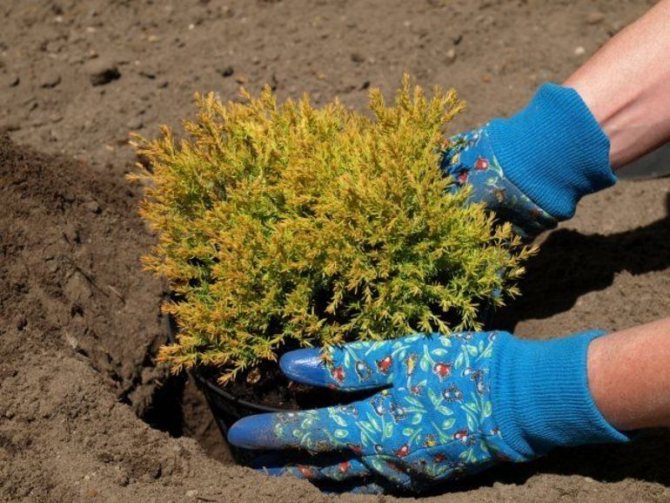

The seedlings must have the color of the needles and the corresponding varietal qualities. A pre-young plant, together with the soil, is placed in water. Depressions are made in the holes 20-30 cm larger than the root system. The seedling is taken out of the water, the soil is shaken off from the roots into the hole, then the young plant is placed by gardeners in the planting hole along the root collar.
The roots are leveled and sprinkled with the prepared mixture. Carefully compact the soil around the trunk and water it again. If seedlings with bare roots were purchased, then they are pretreated with the growth stimulant Kornevin… You can put the roots in a clay mash and treat them with Fundazole to prevent fungal diseases.
Mulch is poured onto the soil around the trunk with a layer of 7-10 cm of peat, sawdust or needles. This helps to retain moisture, and when winter comes, the root system will be protected from frost. It is recommended to loosen the mulch periodically so that air flows to the roots. You can grow a seedling from seeds at home, but this will be a very time-consuming procedure.
Autumn work front
The active preparation of the shrub for winter begins in the fall. Before the shelter of the juniper, the necessary agrotechnical measures are carried out: water-charging irrigation, pruning, treatment from pests and diseases.
Watering and spraying
The need for watering depends on the weather: if the fall is rainy, then the plant does not need additional moisture. Otherwise, if the hot summer has turned into a mild dry autumn, it is necessary to water the juniper once every 1 weeks. For a medium-sized bush, you will need about two ten-liter buckets of water. Immediately before the shelter, 2–4 buckets of water are poured into the near-trunk zone, which is better to loosen a little.
A layer of mulch will help trap moisture and provide ventilation. Spraying has a beneficial effect on the appearance and health of the plant. To do this, you need to use settled water at room temperature. So that the shrub does not suffer from the sun’s rays, which, together with moisture, can burn out the needles, the procedure is recommended to be carried out early in the morning or after sunset.
Trimming

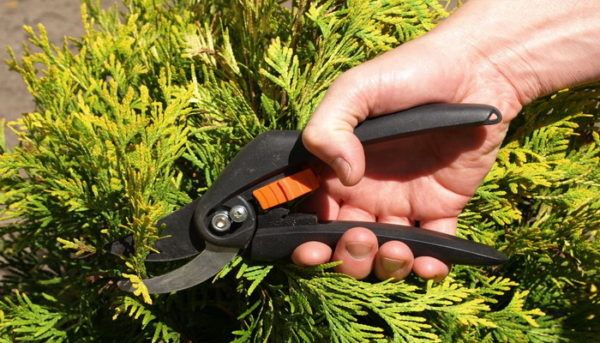
Autumn pruning takes place in mid-November. During it, dry and damaged branches are removed. If necessary, the formation of the crown of the bush takes place in the process. However, when pruning, you should be careful: the shoots grow back slowly. It is impossible to remove too much of the shrub at a time, it will not have time to recover before winter.
Protective measures
The most ardent enemies of juniper are rust and aphids. Dust collectors and spider mites can be just as dangerous. Treatment of the shrub with the drug “Abiga-Peak” will help prevent the development of the disease and cure the plant. For a full result, you will need 4 spraying at intervals of 10 days. Insecticidal preparations “Fitoverm” and “Fufanon” perfectly cope with pests.
How to plant a juniper on a trunk
Planting potatoes in the suburbs
Anyone who decides to start growing a juniper should read some recommendations for proper planting in order to avoid possible mistakes. The planting algorithm consists of several stages:
- If the shrub is large, the distance between the holes must be maintained at least 2 m, and if the plant is small – 0,5 m.
- The depth of the planting hole depends on the size of the clod of earth on the roots. But its depth must necessarily exceed the length of the roots at least 2 times.
- 2 weeks before planting, the bottom of the hole must be covered with sand for drainage or broken brick, the layer height should be 20 cm.Then you need to take a soil mixture, which includes peat, sand, soddy clay soil, mix it with nitroammophos and fill it with 2 / 3 landing pits.
- After the seedling has been placed in the hole, cover with a mixture of soil, but without using fertilizers. In this case, the neck of the root system should be at a distance of 10 cm above the soil surface.
Pay attention! If the plant is not very large, after planting in the ground, the root collar should be flush with the ground.
The final stage is watering the seedlings, and after the water is completely absorbed, it is imperative to cover the trunk circle with mulch. For these purposes, experts advise using peat, chips or sawdust, while the layer thickness should be 5-8 cm.

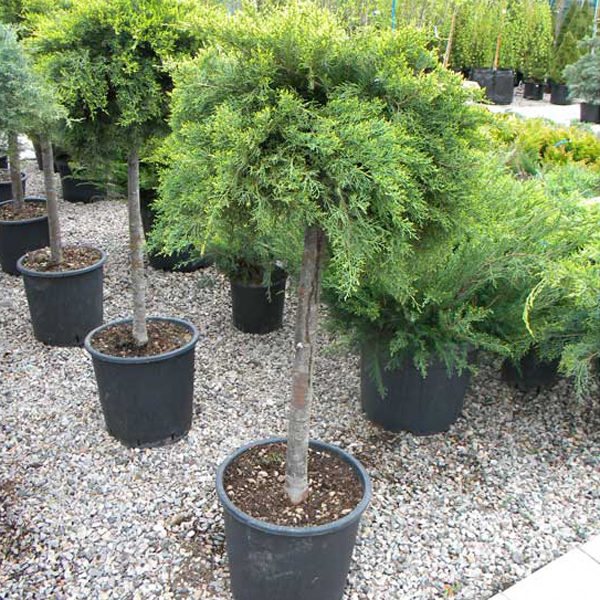
How to plant a juniper on a trunk
Shelter by the rules
After carrying out the necessary agrotechnical measures in the last decade of November, the juniper is covered. The near-trunk zone is mulched with peat, the branches are tied around the trunk. The harness will help prevent damage to branches and freezing of the trunk. You can cover the juniper with:
- Snow. A snowdrift of loose snow falls on the connected structure. It is important to ensure that the snow does not freeze and damage parts of the plant during the shelter process.
- Lapnik. Pine needles are perfectly permeable to air and moisture and at the same time protects the plant from wind, snow and sunlight.
- Burlap or non-woven fabric (agrofibre, spunbond). Part of the bush is wrapped in a special material, leaving the bottom uncovered. The film will not work for this purpose – the plant can resist under it.
- Screen. It is usually installed on the sunny side to accumulate the energy of the sun and warm the plant.
In regions with harsh winters, young animals are often dug up, placed in a container and brought into a cool room. Mature plants are insulated with a special covering material, wrapped several times, and covered with additional snow on top.
Common Mistakes
Ordinary summer residents and inexperienced gardeners often make mistakes that can become irreparable:
- Waterlogging. Abundant watering contributes to waterlogging of the soil and the development of the decay process. Root decay negatively affects the health of the entire plant.
- Improper feeding. Untimely or excessive fertilization of juniper with nitrogen-containing dressings promotes active growth of shoots, which prevents the plant’s root system from accumulating the necessary nutrients for wintering.
- Improper pruning and processing of cuts with garden pitch. Excessive pruning can cause a tree to stop growing and developing. Garden varnish processing “preserves” the cut site and interferes with the emergence of young shoots.
- Use as a top dressing chicken manure or mullein.
Juniper: planting and care
Juniper in the Urals: planting and care
Having chosen a suitable place, having previously prepared the planting pit, you can proceed directly to planting the juniper. Step-by-step actions:
- the seedling is removed from the container, placed in the center of the prepared planting pit;
- the space around the young plant is carefully compacted;
- the near-trunk circle is watered;
- if necessary, the earth is filled up;
- the planting site is mulched to a height of 5 cm with sawdust, peat, pine bark.
The root collar of a young seedling should be at the level of the soil surface. Until the juniper takes root, it needs to be watered frequently, later on as needed.
If for some reason the juniper needed to be transplanted to another place, then first it must be prepared for this. Before planting a juniper and caring for it, deep digging of the plant is performed 2-3 months before transplanting. This will trim the top roots. In October, the juniper is transplanted, its earthen lump is pre-watered.

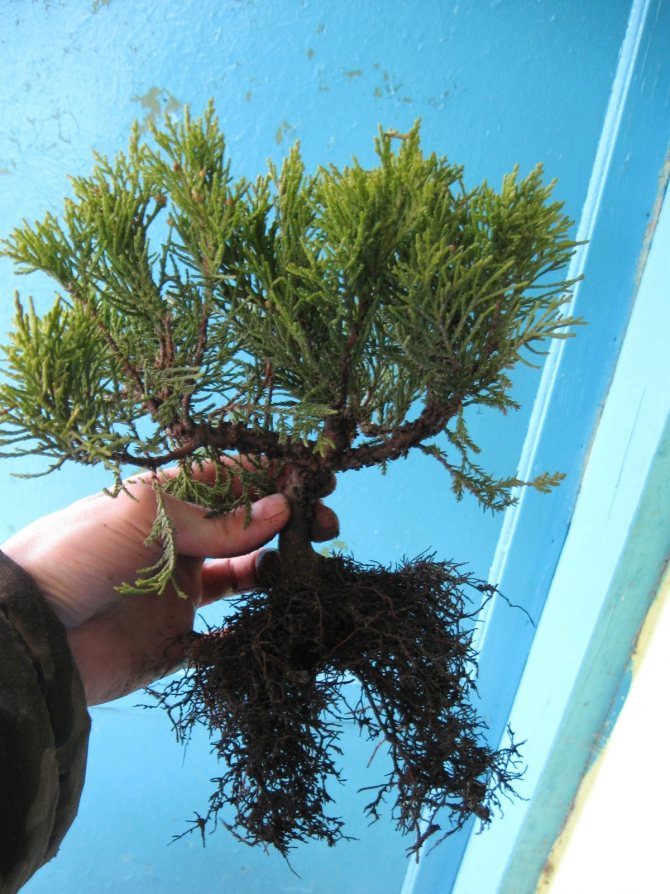
Juniper transplant
In late February and early March, the needles can get burns (a frequent occurrence in Siberia), so they need shading. Burlap is usually used as a cover.
Important! Agrofibre is not used as a covering material, as it transmits ultraviolet rays.
Regional distinctive features
The need for shelter and the method depend on the climatic conditions for the growth of the plant. Juniper care in autumn and summer in different regions also has its own characteristics. In the areas of the Volga region, juniper must be protected primarily from sunburn. For this, the plant is loosely wrapped several times with cotton cloth, burlap, tulle so that the shrub breathes. In the middle lane, the plant is most often covered with spruce branches and snow is poured on top. In Siberia and the Urals, they are wrapped with a special covering material, young trees are dug up and brought into the room.
Description and some features of the juniper
Juniper has been popular among gardeners for decades. It is grown in central Russia, in the Moscow region and even in the Urals. In particular, this is due to its decorative properties, since the plant can be used to decorate hedges in the country and decorate personal plots.

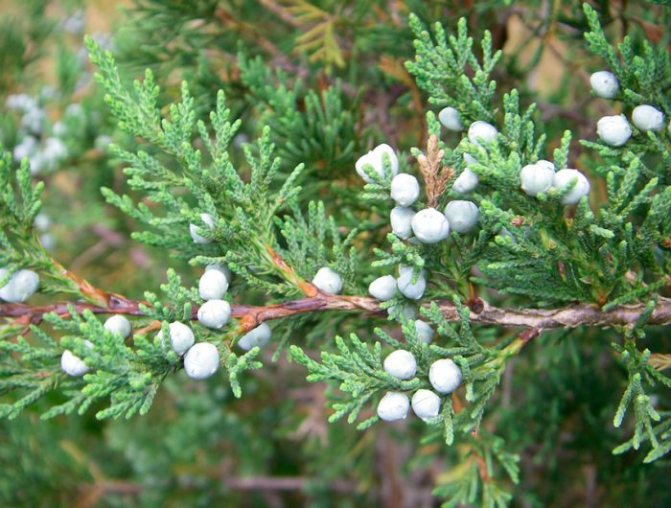
Juniper
Distinctive features of a juniper:
- the height of the shrub can vary from 1 to 3 m, but in some cases you can find plants in which a tree-like shape and in height they reach 8-12 m;
- the juniper has an erect, branched stem;
- young specimens are dark red, and old shrubs are brown;
- the foliage of the culture is characterized by an acicular or scaly shape, one whorl consists of several leaves;
- the fruits of the dioecious shrub are represented by oval green cones, the diameter of which is no more than 0,9 cm.
It is worth noting that this culture has both female and male cones. Male fruits vaguely resemble elongated spikelets, which are oval in shape. They are located on the leaf axils, and their shade is bright yellow.
Pay attention! Coneberries fully ripen after a spirit of years after the plant is planted in open ground. They consist of many seeds, but on the surface you can see only fleshy scales, which are very tightly closed.
You can cultivate various types of shrubs both at home and in the open field. For example, decorative compositions made of juniper are very popular.
Features of caring for junipers in the fall and in preparation for winter – general tips and tricks
Juniper does not have a capricious disposition. But if you do not follow certain rules, then a beautiful plant can wither, it will cease to have a decorative appearance, it will turn into a wild tree.
It is recommended to carry out the following activities for the care of juniper in the autumn period of time:
- Watering – the shrub practically does not require watering. If it turned out to be a hot end of summer, smoothly turning into a velvet autumn, then irrigation with water should be carried out no more than 1 time in 2 weeks. In case of rainy and cool summers, additional watering is not required.
- Spraying – the only moment that the juniper favors. The event is best done before the first hours of the morning or after sunset. This is necessary so that the bright rays do not burn the delicate twigs.
- fertilizers – dressings are applied mainly in the spring. But if the bush is lagging behind in growth or does not add young growth at all, it is necessary to apply mineral fertilizers in the form of nitroammofoska in the fall. But not more often than once every 1 weeks.
- Trimming – if the juniper was planted specifically for decorative purposes and its crown is constantly being formed, then in the autumn period, formative pruning is required. In addition, regardless of whether the figure is formed from a bush or the juniper grows with a natural crown, the removal of excess branches is mandatory. All dry, broken or damaged branches are cut.
- Shelter for the winter – in most cases, additional shelter is not required, the juniper tolerates even a strong decrease in temperature. The only moment so that the bush does not break off the branches, they are bent to the trunk and tied with twine.
Attention! Juniper requires little or no maintenance. The main thing is to monitor the general condition of the bush. If the plant withers and looks unhealthy, you need to look for the cause in improper care, including when preparing for winter.
Growing juniper
Even a beginner can grow a juniper at home. This plant is completely unpretentious to care for, but requires correct and competent planting, choice of soil and a permanent place for growth.
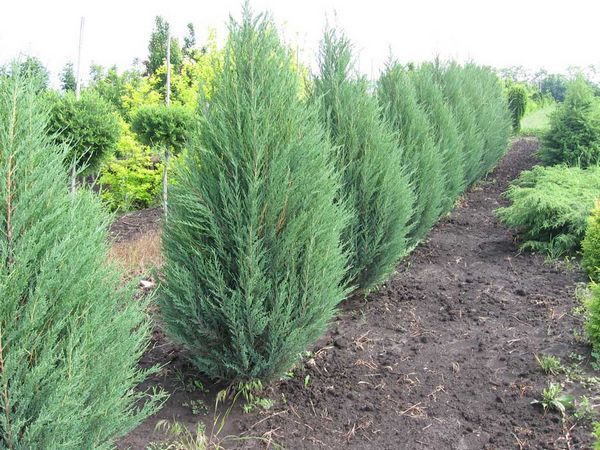
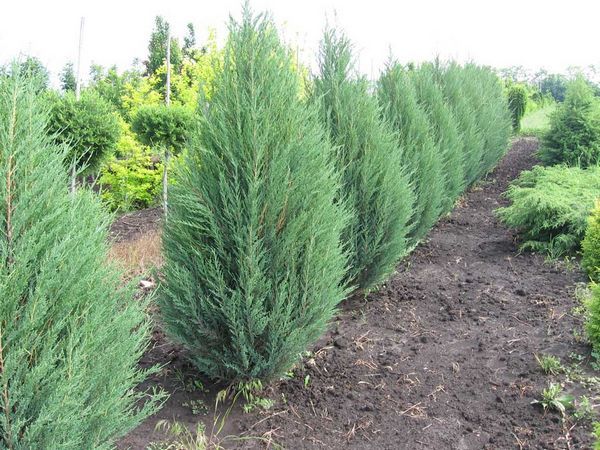
Juniper in the garden
How to plant junipers in the garden, the following tips will tell you. Initially, you need to figure out where to start and how to choose the right variety for your site:
- It should be based on the size of the selected place. It must be remembered that some varieties of bushes have branches (paws) up to 2 meters long and in width it can grow by 1-1,5 meters. In other words, it is worth paying attention to the size of the purchased plant and correlating it with the chosen place. Plant care will also depend on the variety.
- When choosing a place for a future cypress representative, you need to pay attention to good lighting of this area, since the shrub loves sunlight and will need a lot of space for growth. If perennial plants are already growing on this site, then you should take care of the required distance between them and the juniper.
Juniper pruning in autumn
The first pruning can be done only 2-3 years after planting in open ground. This period will allow the young plant to grow stronger and gain weight. After this time, it will be possible to begin to form the crown according to the intended image.
Video: pruning Cossack juniper in autumn or spring
When to prune junipers – fall or spring
Junipers can be pruned during the spring months as well as before the first winter drops in temperature. In autumn, it is recommended to remove excess juniper shoots not earlier than September-October. But you should not delay until the first frost.
Important! The minimum temperature for pruning juniper in the fall is +4 C.
Lower air degrees adversely affect the healing of fresh cuts – they do not heal and are a smart option for wintering pests and diseases.
Timing of pruning juniper in autumn and spring
Spring pruning occurs in early to mid April, and juniper pruning in autumn in September until late October.
How to prune junipers in the fall
The event is only required clean, sharpened and disinfected instruments.
First of all, all dried branches or branches affected by parasites or pathogenic bacteria are cut off. In addition, young shoots that grow inward and thicken the crown are subject to removal.
The bush adds no more than 10 cm per year. Therefore, it is required to cut off no more than 15-20% of the mass that has grown over the past period.
You need to prune only with protective gloves… Juniper poisonous, secretes juice on the cut, which can burn the skin of the hands.
Pruning should be done according to the rules – better less than more. If the pruning has led to the thoughtless removal of growth buds, then the shrub can stop its growth completely.
It is recommended to adhere to the following scheme when pruning juniper in the fall:
- You need to trim so that the slope is 45 degrees per kidney.
- If you cut it lower than required, then the wound on the tree will heal for a long time. This will provoke abnormal growth of the kidney – it can give either a small increase, or it will completely die out (dry out).
- If the shoot looks up, then it is cut so that the final bud is that looks away from the center of the plant (outer bud). In the case of a lowered branch, the pruning is done, on the contrary, to the inner bud.
- When removing branches, a small stump should be left – no more than 2 cm. It will block the upper bud from dying tissues, giving it the opportunity to start growing.
Top dressing and fertilization of juniper after autumn pruning
Important! After pruning the juniper in the fall, you need to monitor its condition. It is recommended to apply special mineral fertilizers. Stimulants-adaptogens are best suited for raising immunity. They stimulate the growth of the root system and strengthen the tree as a whole.
Description of juniper, varietal variety
Juniper is an evergreen coniferous plant of the Cypress family. It can be either a shrub or a tree. In its natural habitat, it is distributed in the Northern Hemisphere from mountainous subtropical regions to the Arctic, which confirms its unpretentiousness and endurance. Juniper is a long-liver – specimens with an age of more than 3000 years are known.
Today, botanists have more than 70 species of juniper, as well as several hundred varietal varieties. Depending on the species and variety, it can be a tall tree reaching 15 meters, or a low-growing creeping shrub. The color of the needles ranges from dark green to golden, bluish, silver or blue, and can also change throughout the year or throughout the life of the plant. The following varieties are considered the brightest representatives of juniper with multi-colored needles:
- AndorraCompact – in the warm season, the needles change shades within the framework of green, in winter they turn purple with a slight lilac tint;
- BlueAlps – a spreading variety, characterized by a soft silver-blue shade of needles;
- OldGold – a medium-sized shrub with a bright crown of golden needles with a bronze tint.
According to the shape of the crown, there are three types of junipers:
- Columnar (tall tree-like forms, up to 2-8 m);
- Medium (bushy forms up to 2 m);
- Ground cover (creeping varieties, the height of which does not exceed 1-1,5 m, but the crown width can reach several meters).
As a rule, juniper shrubs with a height of 1-3 m are grown on the plots, although tree-like forms of this plant are often used to create hedges, reaching 4-8 m.Young plants are distinguished by a pleasant red-brown color of the bark, which eventually changes to a darker one. brown tint. Juniper needles can be of two types – acicular or scaly, they are collected in whorls of several pieces.
Juniper is a dioecious plant, so both male and female cones can be found on the same tree. Womens are distinguished by aroma, spicy sweetish aftertaste. They are small, 5 to 9 mm in diameter, oval and green in color. Male cones are elongated spikelets of bright yellow color that hide in the axils of the needles. In the second year of the juniper’s life, cones with seeds, covered with dense fleshy scales, ripen on it.
Choosing a variety for planting
When choosing a juniper variety for planting on your site, it is important to collect information in advance about its characteristics – winter hardiness, endurance, height and width of an adult plant, crown shape, colors, etc. This will help you choose the right variety that can survive in a frosty winter, especially if the plants come to the nursery from warm southern countries.
When choosing, it is important to take into account the characteristics of the site where the tree will grow, as well as its purpose. If you plan to create a hedge, it is better to take high varieties with a pyramidal or columnar crown shape. Low-growing creeping varieties are more suitable for decorating alpine hills, rocky slopes and gardens.
It is important to remember that Cossack juniper varieties are poisonous, although they are highly decorative and hardy.
Pest and disease control
During leaving it is necessary to monitor the appearance of diseases and pests, although juniper is more resistant to their appearance than other conifers. Young immature plants are mainly affected. Most often, they suffer from the pine moth and the juniper concave moth.
For prophylaxis in the spring, plants are treated with Aktellik, Engio or Decis. If necessary, then after a week the treatment is repeated. The most common diseases are fusarium and rust. For treatment, dried branches are removed, and the ground part is treated with fungicides. Rust-affected plant shoots are cut and burned. The remaining green branches are also treated with fungicides.
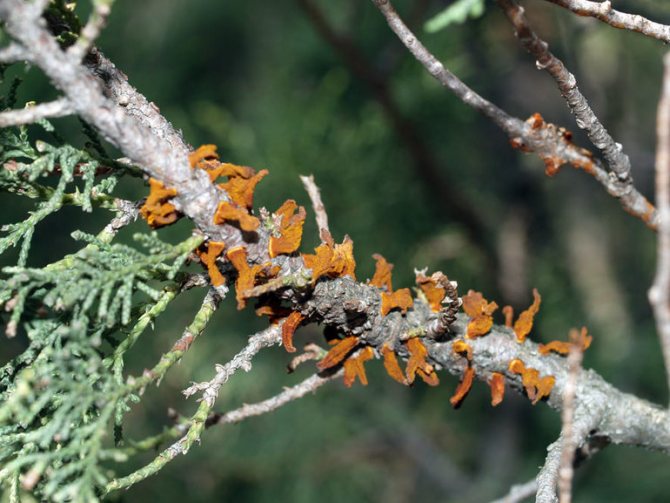
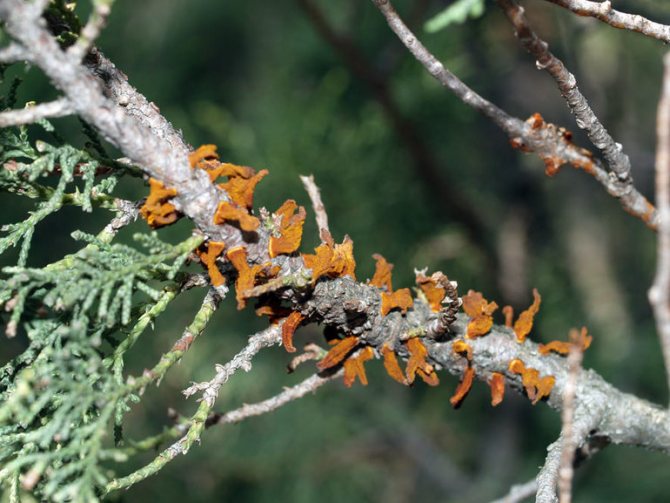
Mainly young plants are prepared for winter by covering them with spruce branches or dead wood. Junipers with a fragile crown are tied and wrapped so that the snow does not damage them. Most adult plants successfully tolerate frosts, the danger is only a little snow and windy winters.
0
Back
Subulate bryozoan: planting, growing and caring for the plant
STILL
